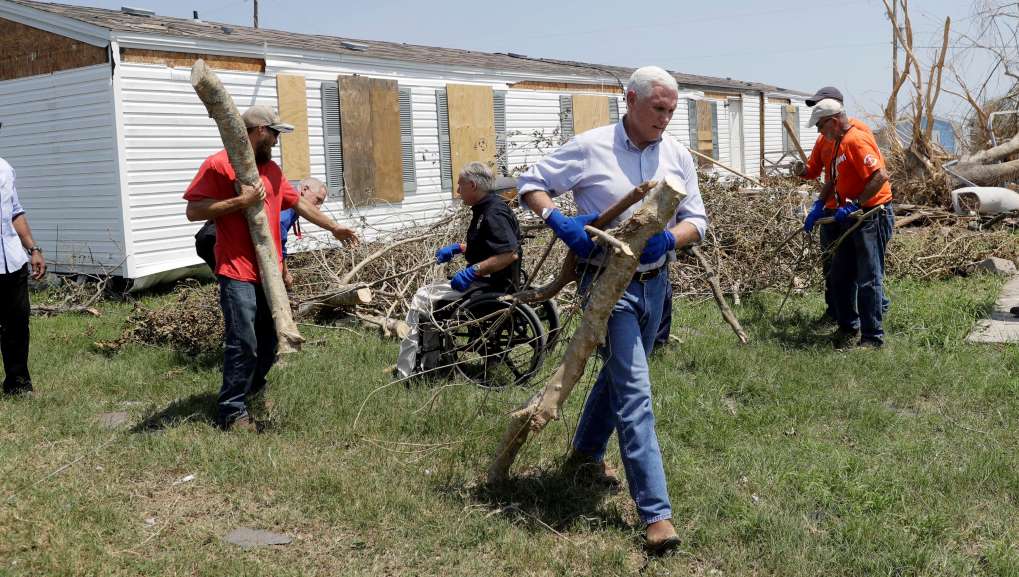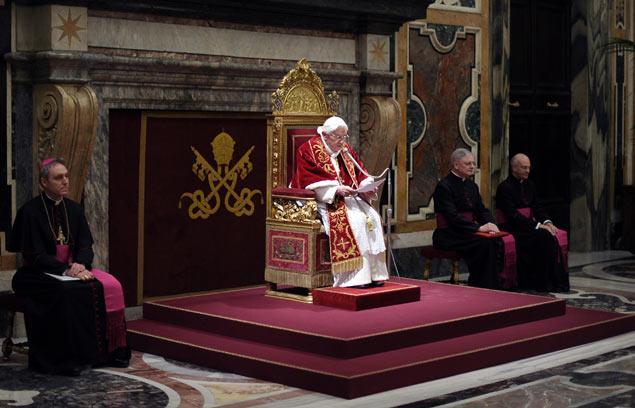August 31, 2017
He hugged victims of Hurricane Harvey and comforted those with tears in their eyes. He prayed and posed for photos, at one point blaring his message of support into a bullhorn.

August 31, 2017
He hugged victims of Hurricane Harvey and comforted those with tears in their eyes. He prayed and posed for photos, at one point blaring his message of support into a bullhorn.

Vice President Pence (center right) and Texas Gov. Greg Abbott (center in wheel chair) help move debris during a visit to an area hit by Hurricane Harvey in Rockport, Tex., on Thursday, Aug. 31, 2017. – Eric Gay/AP
And he donned durable blue gloves and cleared brush, working up a sweat as he dragged debris away from a damaged white mobile home.
Put another way, he did what many other presidents have done in the face of disaster. But the blue jeans-clad man who spent Thursday communing with victims of the 1-in-1,000-year flood event in Southeast Texas was Vice President Pence — not President Trump.
The images of Pence’s trip to Texas on Thursday offered a striking contrast between Trump — who came under bipartisan criticism for initially failing to seem to empathize with those affected by the devastating storm — and his No. 2, who spent the week performing relief duties.
White House officials said the president and the vice president were merely working in tandem to coordinate the federal government’s response to Harvey, magnifying their efforts through complementary skill sets. Trump, after all, visited Texas on Tuesday — though he steered clear of flood areas or victims — and plans another trip to the Gulf Coast on Saturday. Trump also took several moments Wednesday to address “the deeply tragic situation in Texas and Louisiana” before a scheduled speech on taxes in Missouri.
But Harvey put an uncomfortable spotlight yet again on Pence, underscoring the delicate balance the vice president must manage in supporting and complementing the president — while never overshadowing him.
In many ways, Pence’s handling of Harvey — from his visit to the Federal Emergency Management Agency Monday to the slew of local radio interviews he did — would be routine but for the president he serves, a man whose own instinct for public displays of compassion are often unconventional. During Trump’s visit to southeastern Texas on Tuesday, he managed to place himself squarely in the eye of the storm, at one point convening an impromptu if brief political rally. (“What a crowd! What a turnout!” he enthused).
Pence, said Ron Klain, a chief of staff to both former vice presidents Al Gore and Joe Biden, “is doing normal stuff in an abnormal situation.”
“A lot of this other stuff is kind of de rigueur for a vice president, but when you have the president behaving oddly, as he did the other day in Texas, there is an interesting role for the vice president,” Klain said. “If both the president and the vice president console victims, if both are busy speaking out about the loss, if both are busy doing the things that are normal in this situation, then what the vice president is doing is just additive to the situation. What’s striking here is that what the vice president is doing is in some ways substituting for what the president is doing, and that’s what makes it more in the spotlight.”
White House officials said every relief action Pence took this week was part of a methodical, coordinated effort between his and Trump’s teams, with a particular emphasis on communication — one of the most important roles they think the administration can perform during a natural disaster. Trump’s initial Texas trip was intentionally focused on coordinating federal, state and local response, while Pence’s visit two days later offered more latitude to focus on the survivors who are just beginning to rebuild their lives, officials said.
“It is important to over-communicate in a natural disaster to get your message out, and the president deployed the vice president and his whole team to communicate directly to the people in the path of the storm throughout the week,” said Jarrod Agen, Pence’s deputy chief of staff. “That’s leadership and smart management, and that’s what the president provided and directed.”
The president, one senior White House official said, was eager to head to Texas on Tuesday to clearly convey his support for those suffering but was conscious of not wanting to interfere with search-and-rescue efforts or divert resources. His trip on Saturday, the official added, will allow him to personally connect with those affected by the storm.
The two men have been speaking “multiple times” a day, aides to both said, and their teams have been working in lockstep to coordinate the administration’s response. Pence’s speechwriter, for example, checked in with the president’s aides before Pence delivered a speech Wednesday in West Virginia, to better amplify Trump’s message.
“As someone who works closely with both of them, and has witnessed their round-the-clock attention to this crisis, you cannot put a piece of tissue paper between the president and the vice president on their leadership, their management and their messaging of the White House and federal government’s response to Harvey,” said Kellyanne Conway, counselor to the president. “Their messages are repetitive, not competitive.”
Scrutiny of his role has left Pence’s allies and aides exasperated at times, believing that the media hypes — and overanalyzes — just about everything he does. Early in the administration, Pence weathered a spate of articles about how he seemed to be in the dark on several issues, including a high-profile incident in which former national security adviser Michael Flynn misled the vice president about his conversations with the Russian ambassador. Later, news reports said Pence was operating as more of a shadow president with Oval Office aspirations of his own.
Pence can’t, his aides argue, be simultaneously out of the loop and angling for the top job.
“I think the media is looking for a way to drive a wedge between the president and the vice president, and suggest that there are different approaches and different strategies that show division,” said Marc Short, the White House’s director of legislative affairs who previously was a longtime Pence aide. “Whereas I think the White House looks at it and says, ‘There are very complementary and different skill sets that each bring, and therefore it is better to utilize both.’ So the strategies are actually intentional and, in my mind, complementary and harmonious.”
Some of the images of Pence dealing with Harvey, however, raised eyebrows, including photos of him over the weekend in the Situation Room flanked by Cabinet officials while Trump video-conferenced into the meeting from Camp David.
Pence’s Twitter account also sent out — and then deleted — a photo of him seated behind a desk making calls to senators whose states were hardest hit. An aide said Pence was uncomfortable with the tweet because he preferred the focus to be on first responders and heroic Texans, not himself.
In Texas on Thursday, Pence — a loyal-almost-to-the-point-of-obsequious soldier — was careful to repeatedly invoke Trump, including during a news conference at the end of his visit. He made clear he was simply bringing tidings of support and gratitude from the president.
Arriving in Rockport, Tex., Pence told the gathered crowd he had called Trump from Air Force Two.
“Just tell them we love Texas,” Pence said Trump told him to convey.
At that, a woman in the crowd returned attention back to where Pence is most comfortable — away from himself and squarely on his boss: “We love Trump!” she cried.
Courtesy/Source: Washington Post
















































































































